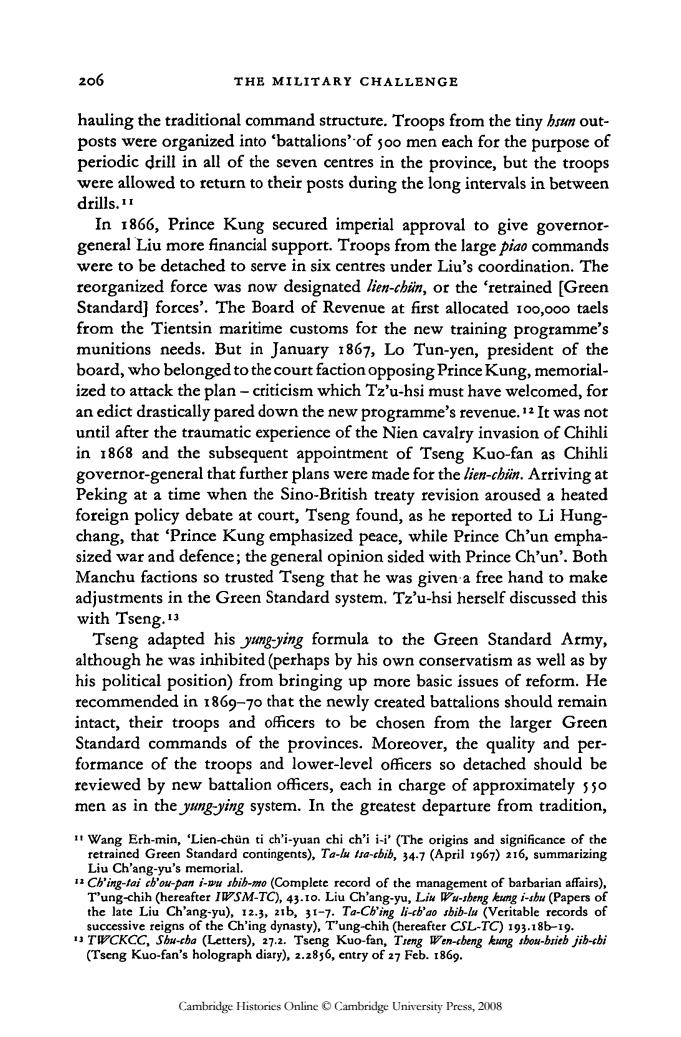正在加载图片...

2o6 THE MILITARY CHALLENGE hauling the traditional command structure.Troops from the tiny brum out- posts were organized into battalions'of soo men each for the purpose of periodic drill in all of the seven centres in the province,but the troops were allowed to return to their posts during the long intervals in between drills. In 1866,Prince Kung secured imperial approval to give governor- general Liu more financial support.Troops from the large piao commands were to be detached to serve in six centres under Liu's coordination.The reorganized force was now designated lien-cbiin,or the 'retrained [Green Standard]forces'.The Board of Revenue at first allocated Ioo,ooo taels from the Tientsin maritime customs for the new training programme's munitions needs.But in January 1867,Lo Tun-yen,president of the board,who belonged to the court faction opposing Prince Kung,memorial- ized to attack the plan-criticism which Tz'u-hsi must have welcomed,for an edict drastically pared down the new programme's revenue.It was not until after the traumatic experience of the Nien cavalry invasion of Chihli in 1868 and the subsequent appointment of Tseng Kuo-fan as Chihli governor-general that further plans were made for the lien-chiin.Arriving at Peking at a time when the Sino-British treaty revision aroused a heated foreign policy debate at court,Tseng found,as he reported to Li Hung- chang,that 'Prince Kung emphasized peace,while Prince Ch'un empha- sized war and defence;the general opinion sided with Prince Ch'un'.Both Manchu factions so trusted Tseng that he was given a free hand to make adjustments in the Green Standard system.Tz'u-hsi herself discussed this with Tseng.13 Tseng adapted his yung-ying formula to the Green Standard Army, although he was inhibited(perhaps by his own conservatism as well as by his political position)from bringing up more basic issues of reform.He recommended in 1869-7o that the newly created battalions should remain intact,their troops and officers to be chosen from the larger Green Standard commands of the provinces.Moreover,the quality and per- formance of the troops and lower-level officers so detached should be reviewed by new battalion officers,each in charge of approximately sso men as in the yung-ying system.In the greatest departure from tradition, t Wang Erh-min,'Lien-chun ti ch'i-yuan chi ch'i i-i'(The origins and significance of the retrained Green Standard contingents),Ta-lu fra-cbib,34.7(April 1967)216,summarizing Liu Ch'ang-yu's memorial. Ch'ing-fai cb'ou-pan i-wu sbib-mo (Complete record of the management of barbarian affairs), Tung-chih (hereafter IWSM-TC),43.10.Liu Ch'ang-yu,Lin Wu-theng erng i-sbu (Papers of the late Liu Ch'ang-yu),12.3,21b,31-7.Ta-Ch'ing li-cb'ao sbib-lu(Veritable records of successive reigns of the Ch'ing dynasty),Tung-chih (hereafter CSL-TC)193.18b-19. 13 TWCKCC,Sbu-cha (Letters),27.2.Tseng Kuo-fan,Treng Wen-cbeng kimng thou-brieb jib-cbi (Tseng Kuo-fan's holograph diary),2.2856,entry of 27 Feb.1869. Cambridge Histories Online O Cambridge University Press,2008206 THE MILITARY CHALLENGE hauling the traditional command structure. Troops from the tiny hsun outposts were organized into 'battalions' of 500 men each for the purpose of periodic drill in all of the seven centres in the province, but the troops were allowed to return to their posts during the long intervals in between drills. •' In 1866, Prince Kung secured imperial approval to give governorgeneral Liu more financial support. Troops from the large piao commands were to be detached to serve in six centres under Liu's coordination. The reorganized force was now designated lien-chiin, or the 'retrained [Green Standard] forces'. The Board of Revenue at first allocated 100,000 taels from the Tientsin maritime customs for the new training programme's munitions needs. But in January 1867, Lo Tun-yen, president of the board, who belonged to the court faction opposing Prince Kung, memorialized to attack the plan - criticism which Tz'u-hsi must have welcomed, for an edict drastically pared down the new programme's revenue.I2 It was not until after the traumatic experience of the Nien cavalry invasion of Chihli in 1868 and the subsequent appointment of Tseng Kuo-fan as Chihli governor-general that further plans were made for the lien-chun. Arriving at Peking at a time when the Sino-British treaty revision aroused a heated foreign policy debate at court, Tseng found, as he reported to Li Hungchang, that 'Prince Kung emphasized peace, while Prince Ch'un emphasized war and defence; the general opinion sided with Prince Ch'un'. Both Manchu factions so trusted Tseng that he was given a free hand to make adjustments in the Green Standard system. Tz'u-hsi herself discussed this with Tseng.13 Tseng adapted his yung-ying formula to the Green Standard Army, although he was inhibited (perhaps by his own conservatism as well as by his political position) from bringing up more basic issues of reform. He recommended in 1869-70 that the newly created battalions should remain intact, their troops and officers to be chosen from the larger Green Standard commands of the provinces. Moreover, the quality and performance of the troops and lower-level officers so detached should be reviewed by new battalion officers, each in charge of approximately 550 men as in the yung-ying system. In the greatest departure from tradition, 11 Wang Erh-min, 'Lien-chun ti ch'i-yuan chi ch'i i-i' (The origins and significance of the retrained Green Standard contingents), Ta-lu tsa-cbib, 34.7 (April 1967) 216, summarizing Liu Ch'ang-yu's memorial. 11 Ch'ing-tai cb'ou-pan i-mu sbih-mo (Complete record of the management of barbarian affairs), T'ung-chih (hereafter IWSM-TC), 43.10. Liu Ch'ang-yu, Uu Wu-sbtng kung i-shu (Papers of the late Liu Ch'ang-yu), 12.3, 21b, 31-7. Ta-Cb'ing li-cb'ao shib-lu (Veritable records of successive reigns of the Ch'ing dynasty), T'ung-chih (hereafter CSL.-TC) 193.18D-19. " TWCKCC, Shu-cha (Letters), 27.2. Tseng Kuo-fan, Tseng Wen-cbeng kung sbou-bsieb jib-tbi (Tseng Kuo-fan's holograph diary), 2.2856, entry of 27 Feb. 1869. Cambridge Histories Online © Cambridge University Press, 2008